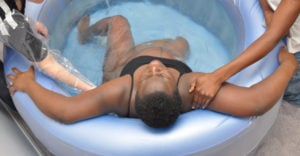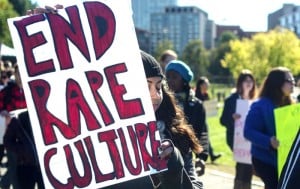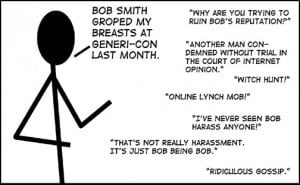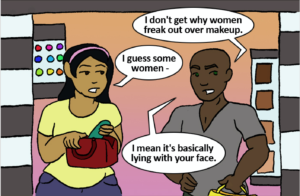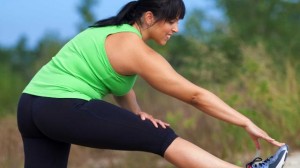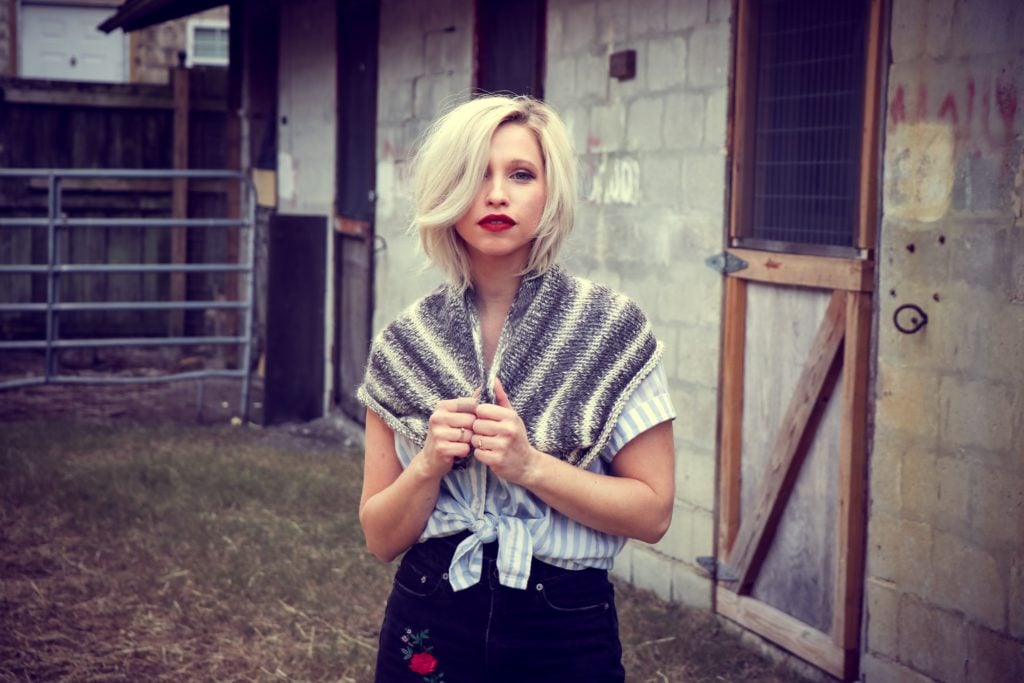
Person standing near barn.
This article was originally published in RESIST, a publication that is no longer in print, and cross-posted here.
(Content warning: animal exploitation; examples of sexism, ableism; descriptions of women in sexually or domestically abusive situations)
The animal rights community has a serious exploitation problem.
I am never surprised to hear when a non-vegan believes that vegans put non-human animals above their human-animal counterparts. Many in the movement consider the issues of animals more urgent than any human rights issue and are not afraid to be public about their beliefs.
It is not a coincidence that the majority of this attitude comes from white, cis-gendered, heterosexual middle-class activists.
For all the aggressive discourse around ending the exploitation of non-human animals and their bodies, human bodies are too often exploited by the animal rights community in ways that reinforce systems of oppression, revictimize survivors with triggering imagery, perpetuate the dangerous and ableist idea that plant-based diets are a magical panacea, and risk the lives of activists during actions.
Selling Sexism and Sexual Violence
When exploring the link between feminism and ethical veganism, it is critical to consider that many animals are exploited specifically for their reproductive capabilities.
Dairy cows, for instance, are forcibly impregnated, forced to give birth, and then their children are taken away from them to be raised for veal, raised as dairy cows to suffer the same fate, or simply killed and thrown away like garbage. Their breast milk is taken away from them while they are still mourning the loss of their baby only to be forcibly impregnated again.
They live in an endless cycle of this until their milk production slows, usually within five years, at which point they are slaughtered and their bodies are turned into low-grade meat to be sold as ground beef or made into dog and cat food.
Their entire value to the dairy industry is in their reproductive organs. As a final, macabre insult, their bodies and likenesses are used to sell us on the idea that they are happy about this exploitation. We have all seen the images of the “happy cow” plastered on our milk cartons, on our cheeses, and in our TV commercials.
It is a sick irony then that the animal rights community is so willing to exploit women’s bodies to sell people on the idea of giving up dairy.
People for the Ethical Treatment of Animals (PETA), certainly not the only but perhaps the most prolific and high-profile perpetrator, is infamous for using sex (well, their heteronormative, cissexist, ableist, whitewashed version of sex anyway) to sell veganism to the masses.
PETA’s ads and public actions center around women (young, white, thin, cis-women) who are almost always naked and/or victimized in some way. Their bodies take the place of animals, supposedly to shock people into making the connection that what we do to non-human animals would be seen as criminal, barbaric or downright evil if done to a human animal.
However, because PETA buys into the idea that sex sells, these brutal images are also highly sexualized ones – essentially reinforcing and, I would argue, even encouraging the link between women’s bodies and sexual violence.
Print ads include women naked and cowering in shackles, women hung up on chains and dismembered, women with outlines on their body indicating different cuts of meat. In many of these ads, the women look scared but also aroused.
Public actions include displaying naked, barcoded women wrapped in plastic and covered in blood on the sidewalk, and women laying on grills with grill marks painted onto their bodies, as if, in both cases, they are literal pieces of meat for our figurative consumption.
In one of their worst commercials, PETA shows a woman walking down the street in her underwear and a large overcoat, sporting a neck brace, carrying a bag full of vegetables. She’s shuffling her feet as she walks, clearly in pain.
The voiceover informs us that this is Jessica, and she has BWVAKTBOOM: Boyfriend Went Vegan And Knocked The Bottom Out Of Me. She gets back to her apartment where we find out that she’s been physically harmed by the rough sex she’s having with her newly vegan boyfriend, who has found endless stamina and can now “bring it like a tantric porn star.”
Beyond the fact that this reeks of toxic masculinity, equating men’s worth with how long they can have sex and how hard they can “bring it,” this also glorifies and excuses domestic abuse and sexual violence.
The website PETA created for this ad campaign has a personal stories section where women are sporting bandages, broken hands, and helmets while they cheerfully talk about inner-thigh bruising and hip dysplasia. The title card for these personal stories lists each woman as a “victim” of BWVAKTBOOM.
However, it is clear that the true message is that these women enjoy being hurt and see their male partners as more of a “real” man now that they can now fuck them into injury. PETA creates many ads and commercials that belittle impotence and equate erections to masculinity, which is intensely damaging for men and dangerous for women.
It is hard for me to write about this without devolving into pure rage. Besides the use of incredibly triggering imagery, which we’ll look at later, this use of battered women’s bodies to sell toxic masculinity to men in the name of saving animals is beyond gross.
Even when shown an injured woman, we are supposed to see her as a sexual object and a testament to her boyfriend’s sexual prowess. Not as a person deserving of compassion and consideration. She is simply there to sell our message, just like that happy cow is there to sell milk.
This culture pervades all animal rights spaces. Blogs, Facebook groups, Instagram accounts, it’s hard to find a corner of the internet where you won’t see support for using women’s looks and bodies to sell animal rights. I can’t tell you how many people I’ve talked to about PETA, men and women alike, who shrug their shoulders and say that if it gets people to go vegan, they’re all for it.
Though women make up about 80% of the vegan community, the mainstream movement is headed by white straight cis-men. The message is clear: if you are a white cis-man, your job is to lead. If you are an attractive (white) cis-woman, your place is to use your body as a commodity to sell others on the ethics of a vegan diet. If you are anyone else, you should stay quiet and unseen.
This tactic furthers the erasure of women of color, fat women and trans women from what is considered attractive. It enhances the objectification of all women, teaching us that, yet again, women need to be quiet and sacrifice ourselves for the greater good, because everyone and everything else is more important than us.
I would be remiss if I didn’t take this opportunity to direct you to Carol J. Adams’ writings on the Sexual Politics of Meat for in-depth, groundbreaking analyses on how the meat and dairy industries use similar tactics to blend sex and animal consumption to sell their products.
How far can we come as a movement if we are using the exact tactics of our adversary? If we are willing to swap out one exploited body for another?
Triggering Tactics
The most painful part of being an animal advocate is the general public’s inability, or unwillingness, to understand that animals are deserving of autonomy over their bodies. It is hard, often impossible, to open someone’s eyes to the injustices we inflict on billions of animals every year simply for the pleasure of wearing, eating, watching or touching them.
It is a heavy burden to carry, to not be able to get otherwise compassionate people to see past the brainwashing; to see that the label “animal” is just a social construct created to excuse and even encourage violence and apathy. We feel the crush of the endless animal lives lost in every moment.
Heavy-hearted activists like me push through our grief and continue having exhausting conversations, all for the chance at cutting through someone’s, anyone’s, speciesism.
We create vegan media; we call ourselves vegan even in polite company. We wear conversation-starting t-shirts; we share information on our Facebook pages. We live by our morals to show that it’s possible to do so. We maintain relationships and let our compassion extend out to those around us.
Other animal rights activists, however, choose to take a much more insidious route by using comparisons to slavery, the holocaust, rape and domestic violence to make the connection between human and non-human suffering.
These ethical vegans use images of lynched black men next to images of strung-up animals to draw a parallel between human slavery and animal exploitation. Images of concentration camps next to images of battery chickens stuffed into rows and rows of cages. Images of domestically abused women next to images of battered animals.
They call the forced impregnation of cows and pigs ‘rape’ and liken the sexual assault of women to the reproductive exploitation of animals. When called on the insensitivity of this, most vegans double-down, telling victims that they are wrong about their feelings and experiences, often citing that “animals have it worse.”
These methods are unnecessary, potentially triggering, alienating, and often inaccurate. Though there are certainly similarities in the tactics used to excuse and encourage violence against particular groups of humans as is used to excuse and encourage the exploitation and slaughter of animals, there are significant differences as well.
All this comparison accomplishes is to turn away potential vegans, teaching them that the animal rights community is an unsafe, hostile space that is willing to exploit their pain but unwilling to listen to their feelings.
Many marginalized people, black folks, in particular, bristle at being compared to animals, as they have suffered this comparison their whole life. Forcing this connection upon them, upon anyone, is an irresponsible and tone-deaf tactic that has no place in what should be an inclusive movement.
It is important to note that sometimes people who do identify as victims, or survivors, of these experiences will use these tactics as well. This is still not ok. While everyone should be able to recover and process in whatever way serves them best, no one should make that decision for someone else.
There are spaces in which it can be appropriate to explore these comparisons, and there are ways to do it that minimize the risk of triggering others. But when we use this imagery in such a general, public way, particularly when we are not directly affected by the comparison, we re-victimize survivors without their consent, which is a cruel and ultimately ineffective tactic.
For a thoughtful expansion on this topic, I highly recommend Christopher Sebastian McJetter’s article, “The Language of Justice: 10 Words to Use in Vegan Advocacy (and a Few to Avoid).”
Capitalizing on Ableism
Recent celebrity deaths have brought ableist vegan tactics to the forefront. I was aghast to discover that, very soon after her passing, the Physician’s Committee for Responsible Medicine (PCRM) published a post by Dr. Neal Barnard on his blog with the headline, “Carrie Fisher’s Heart Attack is a Warning for Women.”
Besides being sexist, this article suggests that Carrie Fisher and all women who suffer heart-attacks are at fault if they do not consume a plant-based diet. This example is especially hurtful because the PCRM and Dr. Barnard are highly respected in the vegan community. They aren’t out for shock value like PETA; they are considered reasoned, logical voices of authority on health and veganism.
This post is only one of many, many examples. Anytime a celebrity passes away, has a medical scare, or is revealed to have gained a significant amount of weight; vegans are eager to claim that a plant-based diet would have cured or prevented the related ailment.
Photos of the celebrity in question are always used to prove the point. Pictures of a non-vegan (typically female-presenting) person will be posted next to a vegan person of the same age to show how much younger, thinner, fitter the vegan looks, not just to sell veganism but also to shame those who consume animal products. It’s similar to tactics used to get people to fear or stop smoking, this idea that you get what you deserve in the form of wrinkles, disease, and weight gain.
Food blogs and Instagram accounts are rife with before-and-after pictures that vilify body fat and anything less than “glowing” skin. Post after post detail how so-and-so cured themselves of chronic illness, mental illness, or even terminal illness using a plant-based diet. These posts are full of pictures of able bodies performing feats of flexibility, thinness or strength; proof of the magic of plants.
Some vegan media stars go as far as to posit that mental illness is all a mindset and that medication is unnecessary, asserting that those that suffer are “not trying hard enough” and likely need to meditate more and tweak their diets.
PETA frequently uses ableism to sell a vegan diet. In one of their most overt anti-fat campaigns, they created billboards that picture a large woman at the beach. “Save the Whales | Lose the Blubber: Go Vegetarian” is the tagline on the image.
Anyone who doesn’t meet the thin/muscular, white, cis-gendered, able-bodied criteria sold by this propaganda finds themselves silenced by the vegan community. Many who fall ill, or who have the audacity to be vegan while fat, are told that they are a danger to the movement and are to blame for their (real or perceived) illness.
Bonsai Aphrodite has a poignant post about her experiences of being sick while vegan. As her tale illustrates, a plant-based diet may reduce your risk of illness, but it does not eliminate it, and in certain situations may even exacerbate or induce symptoms. Disabled activist Michele Kaplan wrote an illuminating post exploring ableism in the vegan community, particularly against the physically disabled.
This practice of promoting ableism to sell veganism is as shameful as it is dangerous. Many vegans have hidden illnesses, developed or deepened eating disorders, or gone back to eating animal products due to the fear or guilt created by this ableist environment.
If we do not make space for the fat, the sick, the tired, our ranks will be perilously barren. If we do not make this space safe for the fat, the sick, the tired, how can we possibly claim to be compassionate or demand compassion from others?
Using Vulnerable Humans as Fodder
The animal rights community loves to argue about which tactics are most effective. You have everything from “bake-tivism,” where you change the world through brownies, up to direct actions (strikes, demonstrations, protests, rallies, disruptions).
In other social justice movements, direct actions have proved powerful tools for change, and are a favorite strategy of the most political among us.
Unfortunately, it is well-known to activists that the the largest proponent of direct actions, Direct Action Everywhere (DxE), is far too willing to use the bodies of their marginalized members to pad their actions, with little to no concern about the lives attached to those bodies.
Many activists have spoken out about DxE’s methods of recruiting young impressionable activists to send out on actions with little, no, or incorrect information about their rights. They say DxE promises to provide legal counsel and to pay for all court fees and bail if an activist is jailed during an action, and then do not follow through, leaving their people to fight legal battles on their own without any resources. Former members say that DxE will go so far as to flat-out lie about the potential consequences of planned disruptions.
Raffaella Ciavatta, co-founder of Compassion Over Killing talks openly about her experience of being pressured into high-risk actions as a queer immigrant who did not yet have her Green Card. Raffaella immigrated to the United States from Brazil on a political asylum petition due to persecution for her sexual orientation; deportation for her could mean imprisonment, violence or even death.
It is important to note that in her speech, Raffaella never specifies which organization this happened with so I don’t want to make that assertion for her. Whether it was DxE or not, it still confirms that the animal rights community has a serious disregard for its marginalized participants, particularly those with intersecting vulnerabilities.
Raffaella’s experiences doing direct actions sadly mirror those of many others. So much so, that a site called Dismantle DxE, was created to give the victims of DxE a space to tell their stories. DxE has shown time and time again that they are willing to exploit their vulnerable volunteers to have more bodies at actions. Only the animals matter.
They are unconcerned with the fact that they have members who could be deported, beaten, raped, imprisoned, or killed if they get involved with the police.
Many vegans like to compare our treatment of animals to the mass incarceration of humans. While this comparison is insensitive and does not hold water, it does bring up a good question: what sense does it make to risk putting humans in cages in order to get animals out of theirs?
***
We Must Do Better
I referenced PETA and DxE a lot in this article because their ads, campaigns, actions and tactics are shared far and wide by many, many animal rights advocates. These organizations would not be as big as they are if they didn’t have widespread support.
They might be the most universally visible, but please believe me when I say I have seen the same sentiments expressed on many Facebook pages, personal blogs and in private conversations.
The animal rights movement needs an overhaul, and it has to start with genuine compassion for one another. Selling veganism at the expense of fellow human beings is as hypocritical as it is short-sighted. How can we ask others to stop commodifying animal bodies when we are so willing to commodify human bodies to make our point?
[do_widget id=’text-101′]
Nichole Dinato went vegan in 2009 after doing gobs of research on how to be at a healthy weight without having to diet. The first two years of her veganism were mostly focused on health and environmental impact. Like Callie, once she started reading more and watching more specifically vegan documentaries, she also became a passionate ethical vegan. Nichole has a vegan food blog that she’s run since 2011 called VeganSpin, where she posts vegan recipes, discusses vegan news, and reviews vegan products and restaurants.
Search our 3000+ articles!
Read our articles about:
Our online racial justice training
Used by hundreds of universities, non-profits, and businesses.
Click to learn more





